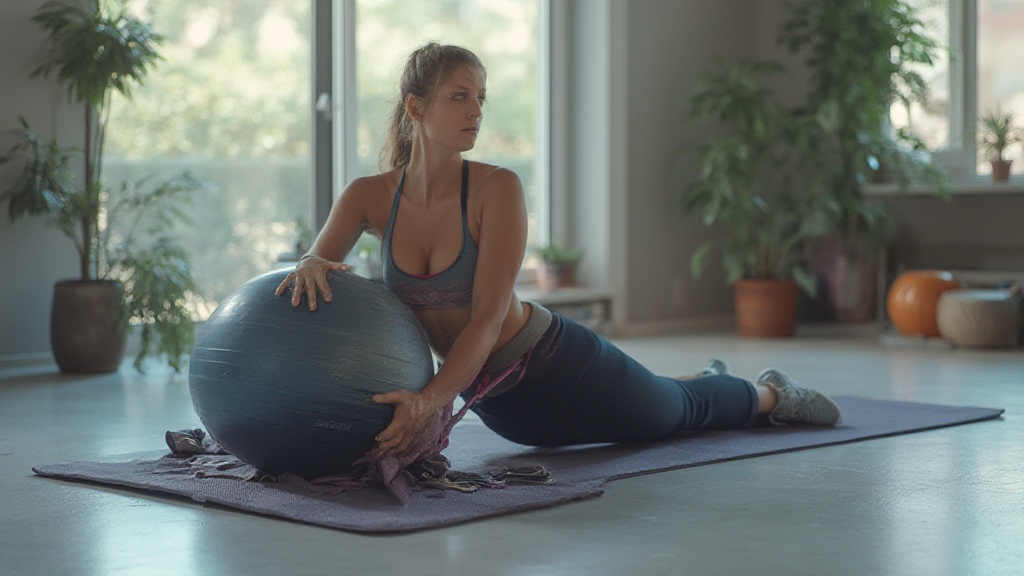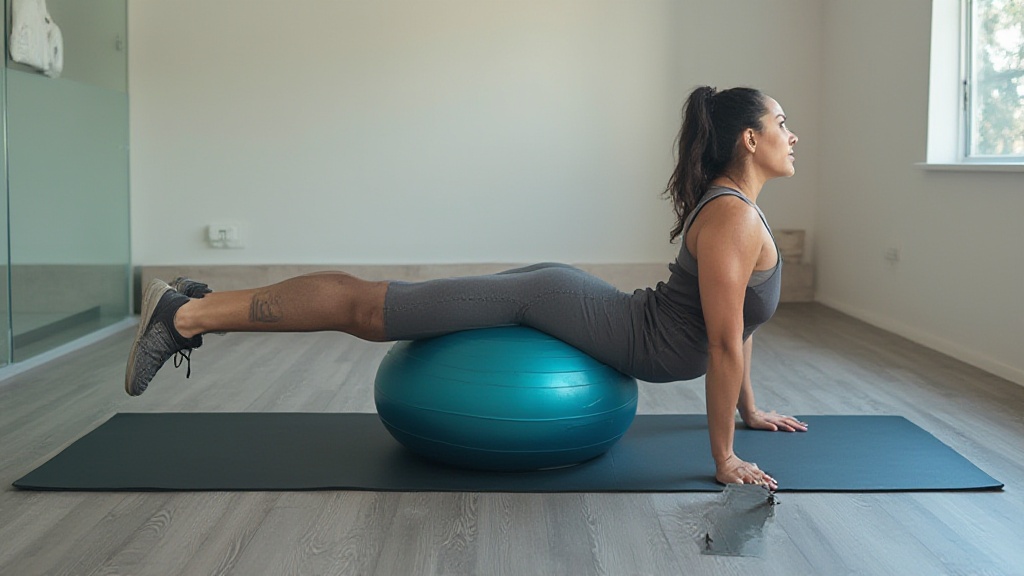
Many fitness enthusiasts underestimate the significance of core stabilization in developing overall strength. Core stabilization refers to the ability to maintain balance and posture during movement, which is essential not only for weightlifting but also for everyday activities.
Emphasizing core stability enhances the effectiveness of various exercises and promotes better muscle engagement.
This focus on the core’s role in functional fitness can guide individuals toward a more effective workout regimen.
Core Strength Benefits
The benefits of core strength extend beyond aesthetics; a strong core is foundational for all forms of exercise, bridging the gap between the upper and lower body.
Core strength provides essential support for movements in weightlifting, running, and sports. This stability enables improved coordination and power transfer during physical activity, making significant contributions to athletic performance.
Core strength aids in injury prevention, as it helps maintain proper body alignment during various exercises.
Key Advantages of Core Strength
- Improved Coordination: Enhanced core strength leads to better control of movement patterns.
- Increased Power Transfer: Optimal core engagement facilitates energy transfer between the upper and lower body.
- Injury Prevention: A well-conditioned core supports the spine, reducing the risk of injuries.
- Enhanced Performance: Athletes benefit from improved dynamic stability and movement efficiency.
A strong core is not just for aesthetics; it plays a vital role in overall fitness.
To begin strengthening your core, consider incorporating the plank exercise into your routine. Focus on maintaining proper form and gradually increasing the duration. This exercise serves as an excellent introduction to core conditioning and can significantly improve your core activation over time.

How Stability Training Enhances Performance
Stability training significantly impacts athletic performance, influencing overall effectiveness in various sports. Athletes benefit from improved stability, as it enhances muscle engagement and supports efficient movement patterns.
Research indicates that athletes with higher stability levels experience reduced injury risks due to better body alignment and neuromuscular control.
Incorporating stability drills into training routines provides benefits that can yield remarkable results.
One such exercise is the single-leg balance, which requires one to stand on one leg for 30 seconds. This drill optimizes core stabilization while improving balance.
Consistent practice facilitates muscle coordination, ultimately enhancing performance and promoting injury prevention.
Incorporating Balance Exercises Into Workouts
Balance exercises form essential components of a well-rounded fitness routine, significantly boosting overall functional fitness. Improved balance directly correlates with enhanced coordination, which is critical for optimal athletic performance.
Many sports, such as gymnastics and soccer, heavily rely on balance for success.
A simple yet effective balance exercise to try at home involves the heel-to-toe walk: participants should walk in a straight line, ensuring the heel of one foot touches the toes of the other.
This exercise not only enhances balance but also strengthens core stability, which can elevate workout routines and contribute to fitness goals.
The Benefits of Balance Exercises
- Enhance coordination and movement efficiency.
- Improve overall functional fitness and athleticism.
- Support injury prevention through better body alignment and proprioception.
Beginner-Friendly Balance Exercise
A beneficial exercise for those new to balance training is the standing single-leg lift. To perform this exercise:
- Stand upright with feet shoulder-width apart.
- Slowly lift one leg, keeping it straight, while maintaining balance on the other leg.
- Hold the position for 20-30 seconds, then switch legs.
This exercise enhances core stability while promoting overall strength development and balance, making it an ideal addition to any workout routine.
Stability and Balance Training
- Research shows that athletes with higher stability experience up to 50% fewer injuries.
- Balance training can improve athletic performance by enhancing coordination by up to 30%.
- Incorporating balance exercises into workouts can lead to a 20% increase in overall functional fitness.
- Studies indicate that core stability training can enhance movement efficiency by improving neuromuscular control.
Exploring Functional Fitness For Daily Life
Functional fitness plays a significant role in enhancing everyday capabilities. By focusing on practical strength applications, individuals can improve their ability to perform daily tasks more efficiently.
Activities like lifting groceries or bending to pick up items become easier and safer with functional fitness.
Simple movements, such as the squat, can be easily incorporated into workout routines to build muscle engagement and overall strength.
This approach emphasizes exercises that mimic real-life activities, helping improve movement efficiency and body stability. Integrating functional fitness into your daily life can result in noticeable benefits and greater physical resilience.
Injury Prevention Through Core Conditioning
Core conditioning serves an essential role in reducing injury risks in daily activities and sports.
By strengthening core muscles, individuals enhance overall stability, which directly contributes to better posture and body alignment. A consistent core strengthening routine can target weaknesses that often lead to injuries.
Recommended exercises include:.
- Planks – These engage multiple muscle groups and promote core activation.
- Bridges – This exercise focuses on spine support and lower body strength.
- Stability drills – Engaging in these exercises enhances dynamic stability and improves balance.
Incorporating core conditioning into fitness routines not only improves core strength but also promotes muscle stability and dynamic balance. It aids in developing neuromuscular control and ensuring proper movement patterns, ultimately enhancing performance and injury prevention.
Functional Fitness and Core Conditioning
- Functional fitness training can improve overall strength by up to 30%, enhancing daily task performance.
- Studies show that core conditioning reduces the risk of injuries by 50% in individuals participating in sports and physical activities.
- Incorporating exercises like planks and bridges can lead to a 20% increase in core stability and balance.
- Engaging in stability drills can improve neuromuscular control, which is essential for efficient movement patterns.
The Role Of Spine Support In Workouts
Spine support plays a pivotal role in ensuring effective workouts. Proper spine alignment serves as the foundation for enhanced performance, directly influencing strength and endurance levels.
Engaging the core muscles effectively stabilizes the spine during various exercises, reducing the risk of injuries.
Studies indicate that individuals who maintain optimal posture while exercising experience fewer injuries and greater functional fitness.
To achieve proper spine alignment, prioritize core activation through exercises such as planks and bridges.
Integrating consistent alignment checks, using mirrors or video feedback, can further enhance training efficiency and safety.
This ultimately leads to improved athletic performance.
Engaging With Pilates Routine For Stability
Incorporating Pilates into your fitness regimen significantly bolsters core strength and stability.
Effective Pilates routines focus on low-impact movements that engage the stabilizing muscles of the core, enhancing overall body alignment. Research indicates consistent practice of Pilates improves functional fitness and promotes flexibility, assisting in injury prevention and performance enhancement.
A great beginner exercise to try is the “Hundred,” which can improve stability through core engagement.
Instructions:
- Begin by lying on your back with your legs in a tabletop position.
- Lift your head and shoulders off the mat while extending your arms alongside you.
- Pump your arms up and down while inhaling for five counts and exhaling for five counts.
Regularly incorporating this exercise into your routine fosters enhanced core conditioning and stability.
Spine Support and Pilates
- Proper spine alignment enhances performance, strength, and endurance during workouts.
- Engaging core muscles reduces the risk of injuries and promotes functional fitness.
- Consistent practice of Pilates improves core strength, stability, and flexibility.
- The “Hundred” exercise effectively engages the core and enhances stability for beginners.
Utilizing Resistance Bands For Core Activation
Resistance bands serve as effective tools for enhancing core activation during workouts. These versatile bands significantly improve core strength by providing adjustable resistance that engages multiple muscle groups.
By integrating resistance bands into your core routine, you can effectively challenge your stability training and achieve better posture improvement.
Effective Exercise for Core Activation
One effective resistance band exercise for core activation is the Resistance Band Plank. This simple exercise involves securing the band around your forearms while in a plank position, ensuring you maintain proper body alignment.
To perform this exercise:.
- Step 1: Secure the resistance band around your forearms while in a plank position.
- Step 2: Engage your core and maintain a straight line from head to heels.
- Step 3: Hold for 30 seconds, focusing on core stabilization.
Benefits of Resistance Band Exercises
Incorporating this exercise into your routine can enhance muscle engagement, leading to improved functional fitness and endurance training. Regular practice not only boosts core conditioning but also ensures better overall movement efficiency and injury prevention. Resistance bands facilitate increased neuromuscular control through dynamic stability challenges, making them ideal for enhancing athletic performance.
Utilizing resistance bands for core activation can significantly impact your training outcomes, promoting overall fitness progression.
Resistance Bands for Core Activation
- Resistance bands provide adjustable resistance, allowing for tailored workouts that engage various muscle groups.
- Exercises like the Resistance Band Plank enhance core stabilization and improve body alignment.
- Regular use of resistance bands can lead to better functional fitness and increased endurance.
- Incorporating resistance bands into training can enhance neuromuscular control and athletic performance.
